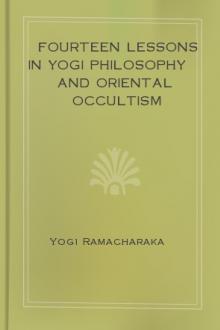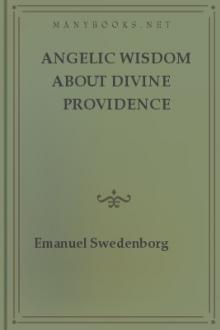A Series of Lessons in Gnani Yoga by William Walker Atkinson (best ereader for pc .txt) 📕

- Author: William Walker Atkinson
- Performer: 1428013288
Book online «A Series of Lessons in Gnani Yoga by William Walker Atkinson (best ereader for pc .txt) 📕». Author William Walker Atkinson
The crystal forms from the mother liquor, and its body is built up systematically, regularly, and according to a well defined plan or pattern, just as are the body and bones of the animal form, and the wood and bark of the tree. There is life at work in the growth of the crystal. And not only does the crystal grow, but it also reproduces itself by separation or splitting-off, just as is the case with the lower forms of life, just mentioned.
The principal point of difference between the growth and development of the crystals and that of the lower forms of life referred to is that the crystal takes its nourishment from the outside, and builds up from its outer surface, while the Monera absorbs its nourishment from within, and grows outwardly from within. If the crystal had a soft center, and took its nourishment in that way, it would be almost identical with the Diatom, or, if the Diatom grew from the outside, it would be but a crystal. A very fine dividing line.
Crystals, like living forms, may be sterilized and rendered incapable of reproduction by chemical process, or electrical discharges. They may also be "killed" and future growth prevented in this manner. Surely this looks like "Life," does it not?
To realize the importance of this idea of life among the crystals, we must remember that our hardest rocks and metals are composed of crystals, and that the dirt and earth upon which we grow and live are but crumbled rock and miniature crystals. Therefore the very dust under our feet is alive. There is nothing dead. There is no transformation of "dead matter" into live plant matter, and then into live animal matter. The chemicals are alive, and from chemical to man's body there is but a continuous change of shape and form of living matter. Any man's body, decomposing, is again resolved into chemicals, and the chain begins over again. Merely changes in living forms—that's all, so far as the bodies are concerned.
Nature furnishes us with many examples of this presence of life in the inorganic world. We have but to look around to see the truth of the statement that All is Alive. There is that which is known as the "fatigue of elasticity" in metals. Razors get tired, and require a rest. Tuning forks lose their powers of vibration, to a degree, and have to be given a vacation. 'Machinery in mills and manufactories needs an occasional day off. Metals are subject to disease and infection, and have been poisoned and restored by antidotes. Window glass, especially stained glass, is subject to a disease spreading from pane to pane.
Men accustomed to handling and using tools and machinery naturally drop into the habit of speaking of these things as if they were alive. They seem to recognize the presence of "feeling" in tools or machine, and to perceive in each a sort of "character" or personality, which must be respected, humored, or coaxed in order to get the best results.
Perhaps the most valuable testimony along these lines, and which goes very far toward proving the centuries-old theories of the Yogis regarding Omnipresent Life, comes from Prof. J. Chunder Bose, of the Calcutta University, a Hindu educated in the English Universities, under the best teachers, and who is now a leading scientific authority in the western world, tie has given to the world some very valuable scientific information along these lines in his book entitled "Response in the Living and Non-living," which has caused the widest comment and created the greatest interest among the highest scientific authorities. His experiments along the lines of the gathering of evidence of life in the inorganic forms have revolutionized the theories of modern science, and have done much to further the idea that life is present everywhere, and that there is no such thing as dead matter.
He bases his work upon the theory that the best and only true test for the presence of life in matter is the response of matter to external stimulus. Proceeding from this fundamental theory he has proven by in-numerable experiments that so-called inorganic matter, minerals, metals, etc., give a response to such stimulus, which response is similar, if not identical, to the response of the matter composing the bodies of plants, animals, men.
He devised delicate apparatus for the measurement of the response to the outside stimulus, the degree, and other evidence being recorded in traces on a revolving cylinder. The tracings or curves obtained from tin and other metals, when compared with those obtained from living muscle, were found to be identical. He used a galvanometer, a very delicate and accurate scientific instrument, in his experiments. This instrument is so finely adjusted that the faintest current will cause a deflection of the registering needle, which is delicately swung on a tiny pivot. If the galvanometer be attached to a human nerve, and the end of the nerve be irritated, the needle will register.
Prof. Bose found that when he attached the galvanometer to bars of various metals they gave a similar response when struck or twisted. The greater the irritation applied to the metal, the greater the response registered by the instrument. The analogy between the response of the metal and that of the living muscle was startling. For instance, just as in the case of the living animal muscle or nerve matter, the response becomes fatigued, so in the case of the metal the curve registered by the needle became fainter and still fainter, as the bar became more and more fatigued by the continued irritation. And again, just after such fatigue the muscle would become rested, and would again respond actively, so would the metal when given a chance to recuperate.
Tetanus due to shocks constantly repeated, was caused and recovered. Metals recorded evidences of fatigue. Drugs caused identical effects on metals and animals—some exciting; some depressing; some killing. Some poisonous chemicals killed pieces of metal, rendering them immobile and therefore incapable of registering records on the apparatus. In some cases antidotes were promptly administered, and saved the life of the metal.
Prof. Bose also conducted experiments on plants in the same way. Pieces of vegetable matter were found to be capable of stimulation, fatigue, excitement, depression, poison. Mrs. Annie Besant, who witnessed some of these experiments in Calcutta, has written as follows regarding the experiments on plant life: "There is something rather pathetic in seeing the way in which the tiny spot of light which records the pulses in the plant, travels in ever weaker and weaker curves, when the plant is under the influence of poison, then falls into a final despairing straight line, and—stops. One feels as though a murder has been committed—as indeed it has."
In one of Prof. Bose's public experiments he clearly demonstrated that a bar of iron was fully as sensitive as the human body, and that it could be irritated and stimulated in the same way, and finally could be poisoned and killed. "Among such phenomena," he asks, "how can we draw the line of demarkation, and say, 'Here the physical ends, and there the physiological begins'? No such barrier exists." According to his theory, which agrees with the oldest occult theories, by the way, life is present in every object and form of Nature, and all forms respond to external stimulus, which response is a proof of the presence of life in the form.
Prof. Bose's great book is full of the most startling results of experiments. He proves that the metals manifest something like sleep; can be killed; exhibit torpor and sluggishness; get tired or lazy; wake up; can be roused into activity; may be stimulated, strengthened, weakened; suffer from extreme cold and heat; may be drugged or intoxicated, the different metals manifesting a different response to certain drugs, just as different men and animals manifest a varying degree of similar resistance. The response of a piece of steel subjected to the influence of a chemical poison shows a gradual fluttering and weakening until it finally dies away, just as animal matter does when similarly poisoned. When revived in time by an antidote, the recovery was similarly gradual in both metal and muscle. A remarkable fact is noted by the scientist when he tells us that the very poisons that kill the metals are themselves alive and may be killed, drugged, stimulated, etc., showing the same response as in the case of the metals, proving the existence in them of the same life that is in the metals and animal matter that they influence.
Of course when these metals are "killed" there is merely a killing of the metal as metal—the atoms and principles of which the metal is composed remaining fully alive and active, just as is the case with the atom of the human body after the soul passes out—the body is as much alive after death as during the life of the person, the activity of the parts being along the lines of dissolution instead of construction in that case.
We hear much of the claims of scientists who announce that they are on the eve of "creating life" from non-living matter. This is all nonsense—life can come only from life. Life from non-life is an absurdity. And all Life comes from the One Life underlying All. But it is true that Science has done, is doing, and will do, something very much like "creating life," but of course this is merely changing the form of Life into other forms—the lesser form into the higher—just as one produces a plant from a seed, or a fruit from a plant. The Life is always there, and responds to the proper stimulus and conditions.
A number of scientists are working on the problem of generating living forms from inorganic matter. The old idea of "spontaneous generation," for many years relegated to the scrap-pile of Science, is again coming to the front. Although the theory of Evolution compels its adherents to accept the idea that at one time in the past living forms sprung from the non-living (so-called), yet it has been generally believed that the conditions which brought about this stage of evolution has forever passed. But the indications now all point to the other view that this stage of evolution is, and always has been, in operation, and that new forms of life are constantly evolving from the inorganic forms. "Creation," so-called (although the word is an absurdity from the Yogi point of view), is constantly being performed.
Dr. Charlton Bastian, of London, Eng., has long been a prominent advocate of this theory of continuous spontaneous generation. Laughed down and considered defeated by the leading scientific minds of a generation ago, he still pluckily kept at work, and his recent books were like bombshells in the orthodox scientific camp. He has taken more than five thousand photo-micrographs, all showing most startling facts in connection with the origin of living forms from the inorganic. He claims that the microscope reveals the development in a previously clear liquid of very minute black spots, which gradually enlarge and transform into bacteria—living forms of a very low order. Prof. Burke, of Cambridge, Eng., has demonstrated that he may produce in sterilized boullion, subjected to the action of sterilized radium chloride, minute living bodies which manifest growth and subdivision. Science is being gradually forced to the conclusion that living forms are still arising in the world by natural processes, which is not at all remarkable when one remembers that natural law is uniform and continuous. These recent discoveries go to swell the already large list of modern scientific ideas which correspond with the centuries-old Yogi teachings. When the Occult explanation that there is Life in everything, inorganic as well as organic, and that evolution is constant, is heard, then may we see that these experiments simply prove that the forms of life may be changed and developed—not that Life may be "created."
The chemical and mineral world furnish us with many instances of the growth and development of forms closely resembling the forms of the vegetable world. What is known as "metallic vegetation," as shown in the "lead tree," gives us an interesting example of this phenomenon. The experiment is performed by placing in a wide-necked bottle a clear acidulated solution of acetate of lead. The bottle is corked, a piece of copper wire being fastened to the cork, from which wire is suspended a piece of zinc, the latter hanging as nearly as possible in the center of the lead solution. When the bottle





Comments (0)